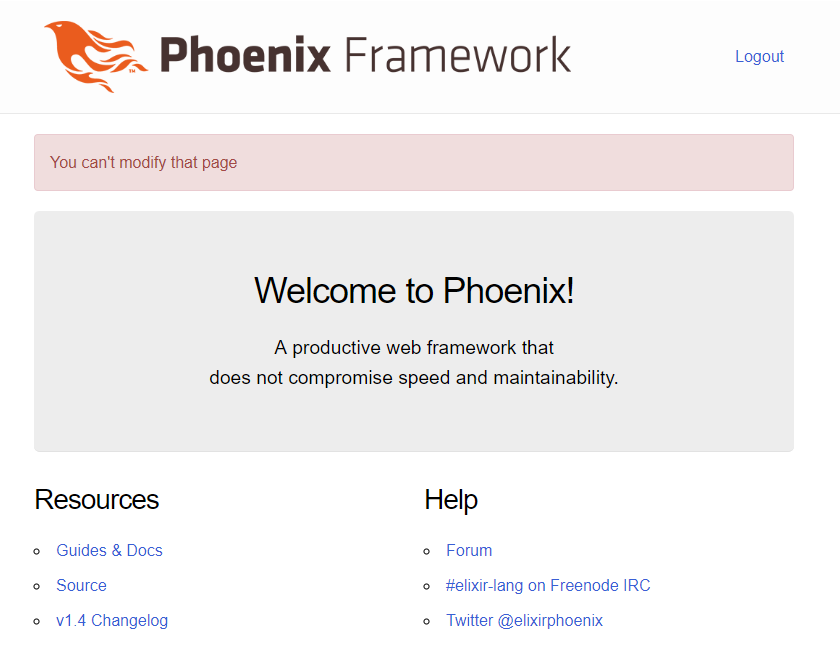|> いいよね!Elixir!
(この記事は Elixir Advent Calendar 2018 6日目です。前回はkikuyutaさんのElixir を使うようになった経緯 〜電力システム制御の現場から〜です!)
前編は「fukuoka.ex Elixir/Phoenix Advent Calendar 2018」の2日目に掲載しています
|> 【Phoenix1.4】(前編)パスワード認証&リレーションあり「ブログチュートリアル」
それでは後半をお楽しみ下さい!
|> 自分自身のuserリソースのみ変更できるように修正
|> userリソース
さて前編までで、基本的なログイン機能はできたのですが、今のままだと他の人のユーザアカウントをeditしたりdeleteすることができてしまいます
userコントローラのshowやindexメソッドは許可してedit, update, deleteメソッドを許可しないような実装にしてみましょう
現状こうなっていますが
defmodule ExBlogWeb.UserController do
use ExBlogWeb, :controller
alias ExBlog.Accounts
alias ExBlog.Accounts.User
def index(conn, _params) do
users = Accounts.list_users()
render(conn, "index.html", users: users)
end
def new(conn, _params) do
changeset = Accounts.change_user(%User{})
render(conn, "new.html", changeset: changeset)
end
def create(conn, %{"user" => user_params}) do
case Accounts.create_user(user_params) do
{:ok, _user} ->
conn
|> put_flash(:info, "User created successfully.")
|> redirect(to: Routes.page_path(conn, :index))
{:error, %Ecto.Changeset{} = changeset} ->
render(conn, "new.html", changeset: changeset)
end
end
def show(conn, %{"id" => id}) do
user = Accounts.get_user!(id)
render(conn, "show.html", user: user)
end
def edit(conn, %{"id" => id}) do
user = Accounts.get_user!(id)
changeset = Accounts.change_user(user)
render(conn, "edit.html", user: user, changeset: changeset)
end
def update(conn, %{"id" => id, "user" => user_params}) do
user = Accounts.get_user!(id)
case Accounts.update_user(user, user_params) do
{:ok, user} ->
conn
|> put_flash(:info, "User updated successfully.")
|> redirect(to: Routes.user_path(conn, :show, user))
{:error, %Ecto.Changeset{} = changeset} ->
render(conn, "edit.html", user: user, changeset: changeset)
end
end
def delete(conn, %{"id" => id}) do
user = Accounts.get_user!(id)
{:ok, _user} = Accounts.delete_user(user)
conn
|> put_flash(:info, "User deleted successfully.")
|> redirect(to: Routes.user_path(conn, :index))
end
end
以下のように変更します
プライベートメソッドであるis_authorizedを定義して、アクセスしたuserリソースのidとログイン中のuserのidが一致するかを確かめます
edit, update, deleteメソッドの実行前にis_authorizedを実行するPlugを定義します(Railsでいうとbefore_actionみたいなの)
各edit, update, deleteの実行はis_authrizedの後、つまりcurrent_userに対する操作だけすればいいのでリクエストのidは気にしなくてよくなります
あと、ついでにuser登録後についでにログインするようにしておきます
defmodule ExBlogWeb.UserController do
use ExBlogWeb, :controller
alias ExBlog.Accounts
alias ExBlog.Accounts.User
+ alias ExBlog.Accounts.Guardian
+
+ plug :is_authorized when action in [:edit, :update, :delete]
def index(conn, _params) do
users = Accounts.list_users()
render(conn, "index.html", users: users)
end
def new(conn, _params) do
changeset = Accounts.change_user(%User{})
render(conn, "new.html", changeset: changeset)
end
def create(conn, %{"user" => user_params}) do
case Accounts.create_user(user_params) do
- {:ok, _user} ->
+ {:ok, user} ->
conn
|> put_flash(:info, "User created successfully.")
- |> redirect(to: Routes.page_path(conn, :index))
+ |> Guardian.Plug.sign_in(user)
+ |> redirect(to: Routes.user_path(conn, :show, user))
{:error, %Ecto.Changeset{} = changeset} ->
render(conn, "new.html", changeset: changeset)
end
end
def show(conn, %{"id" => id}) do
user = Accounts.get_user!(id)
render(conn, "show.html", user: user)
end
- def edit(conn, %{"id" => id}) do
- user = Accounts.get_user!(id)
- changeset = Accounts.change_user(user)
- render(conn, "edit.html", user: user, changeset: changeset)
+ def edit(conn, _) do
+ changeset = Accounts.change_user(conn.assigns.current_user)
+ render(conn, "edit.html", user: conn.assigns.current_user, changeset: changeset)
end
- def update(conn, %{"id" => id, "user" => user_params}) do
- user = Accounts.get_user!(id)
+ def update(conn, %{"user" => user_params}) do
+ user = conn.assigns.current_user
case Accounts.update_user(user, user_params) do
{:ok, user} ->
conn
|> put_flash(:info, "User updated successfully.")
|> redirect(to: Routes.user_path(conn, :show, user))
{:error, %Ecto.Changeset{} = changeset} ->
render(conn, "edit.html", user: user, changeset: changeset)
end
end
- def delete(conn, %{"id" => id}) do
- user = Accounts.get_user!(id)
- {:ok, _user} = Accounts.delete_user(user)
+ def delete(conn, _) do
+ {:ok, _user} = Accounts.delete_user(conn.assigns.current_user)
conn
+ |> Guardian.Plug.sign_out()
|> put_flash(:info, "User deleted successfully.")
- |> redirect(to: Routes.user_path(conn, :index))
+ |> redirect(to: Routes.page_path(conn, :index))
end
+ defp is_authorized(conn, _) do
+ current_user = Accounts.current_user(conn)
+ if current_user.id == String.to_integer(conn.params["id"]) do
+ assign(conn, :current_user, current_user)
+ else
+ conn
+ |> put_flash(:error, "You can't modify that page")
+ |> redirect(to: Routes.page_path(conn, :index))
+ |> halt()
+ end
+ end
end
accountsに現在のユーザを返すメソッドを追加します
+ def current_user(conn) do
+ Guardian.Plug.current_resource(conn)
+ end
これで自分以外のuserリソースをeditやupdateやdeleteしようとすると以下のようにフラッシュが出ます
articleリソースも同様に権限管理できますが、ログインを実装しarticleのcreateにuserリソースを関連付けることができるようになったので、まずはリレーションから進めていきたいと思います
|> リレーションを使って特定のuserが持つarticleの一覧を表示させる
さて、まずはuserが属するAccountsコンテキストとarticleが属するBlogコンテキストを変更します
articleやuserを取得するときにRepo.preload()をパイプさせることで、リレーション先のテーブルを取得できます
また、create_articleメソッドではuserを引数に取り、そのidをuser_idカラムに追加する処理を追加します
defmodule ExBlog.Accounts do
@moduledoc """
The Accounts context.
"""
import Ecto.Query, warn: false
alias ExBlog.Repo
alias ExBlog.Accounts.User
alias Comeonin.Bcrypt
+ alias ExBlog.Accounts.Guardian
@doc """
Returns the list of users.
## Examples
iex> list_users()
[%User{}, ...]
"""
def list_users do
- Repo.all(User)
+ User
+ |> Repo.all()
+ |> Repo.preload(:articles)
end
@doc """
Gets a single user.
Raises `Ecto.NoResultsError` if the User does not exist.
## Examples
iex> get_user!(123)
%User{}
iex> get_user!(456)
** (Ecto.NoResultsError)
"""
- def get_user!(id), do: Repo.get!(User, id)
+ def get_user!(id) do
+ User
+ |> Repo.get!(id)
+ |> Repo.preload(:articles)
+ end
@doc """
Creates a user.
## Examples
iex> create_user(%{field: value})
{:ok, %User{}}
iex> create_user(%{field: bad_value})
{:error, %Ecto.Changeset{}}
"""
def create_user(attrs \\ %{}) do
%User{}
|> User.changeset(attrs)
|> Repo.insert()
end
@doc """
Updates a user.
## Examples
iex> update_user(user, %{field: new_value})
{:ok, %User{}}
iex> update_user(user, %{field: bad_value})
{:error, %Ecto.Changeset{}}
"""
def update_user(%User{} = user, attrs) do
user
|> User.changeset(attrs)
|> Repo.update()
end
@doc """
Deletes a User.
## Examples
iex> delete_user(user)
{:ok, %User{}}
iex> delete_user(user)
{:error, %Ecto.Changeset{}}
"""
def delete_user(%User{} = user) do
Repo.delete(user)
end
@doc """
Returns an `%Ecto.Changeset{}` for tracking user changes.
## Examples
iex> change_user(user)
%Ecto.Changeset{source: %User{}}
"""
def change_user(%User{} = user) do
User.changeset(user, %{})
end
def authenticate_user(email, plain_text_password) do
query = from u in User, where: u.email == ^email
Repo.one(query)
|> check_password(plain_text_password)
end
defp check_password(nil, _), do: {:error, "Incorrect username or password"}
defp check_password(user, plain_text_password) do
case Bcrypt.checkpw(plain_text_password, user.password) do
true -> {:ok, user}
false -> {:error, "Incorrect username or password"}
end
end
def current_user(conn) do
Guardian.Plug.current_resource(conn)
end
end
defmodule ExBlog.Blog do
@moduledoc """
The Blog context.
"""
import Ecto.Query, warn: false
alias ExBlog.Repo
alias ExBlog.Blog.Article
+ alias ExBlog.Accounts.User
@doc """
Returns the list of articles.
## Examples
iex> list_articles()
[%Article{}, ...]
"""
def list_articles do
- Repo.all(Article)
+ Article
+ |> Repo.all()
+ |> Repo.preload(:user)
end
@doc """
Gets a single article.
Raises `Ecto.NoResultsError` if the Article does not exist.
## Examples
iex> get_article!(123)
%Article{}
iex> get_article!(456)
** (Ecto.NoResultsError)
"""
- def get_article!(id), do: Repo.get!(Article, id)
+ def get_article!(id) do
+ Article
+ |> Repo.get!(id)
+ |> Repo.preload(:user)
+ end
@doc """
Creates a article.
## Examples
iex> create_article(%{field: value})
{:ok, %Article{}}
iex> create_article(%{field: bad_value})
{:error, %Ecto.Changeset{}}
"""
- def create_article(attrs \\ %{}) do
+ def create_article(%User{} = user, attrs \\ %{}) do
%Article{}
|> Article.changeset(attrs)
+ |> Ecto.Changeset.put_change(:user_id, user.id)
|> Repo.insert()
end
@doc """
Updates a article.
## Examples
iex> update_article(article, %{field: new_value})
{:ok, %Article{}}
iex> update_article(article, %{field: bad_value})
{:error, %Ecto.Changeset{}}
"""
def update_article(%Article{} = article, attrs) do
article
|> Article.changeset(attrs)
|> Repo.update()
end
@doc """
Deletes a Article.
## Examples
iex> delete_article(article)
{:ok, %Article{}}
iex> delete_article(article)
{:error, %Ecto.Changeset{}}
"""
def delete_article(%Article{} = article) do
Repo.delete(article)
end
@doc """
Returns an `%Ecto.Changeset{}` for tracking article changes.
## Examples
iex> change_article(article)
%Ecto.Changeset{source: %Article{}}
"""
def change_article(%Article{} = article) do
Article.changeset(article, %{})
end
end
create_articleメソッドを変更したので呼び出し側のarticleコントローラも引数を変更します
def create(conn, %{"article" => article_params}) do
- case Blog.create_article(article_params) do
+ case Blog.create_article(Guardian.Plug.current_resource(conn), article_params) do
{:ok, article} ->
conn
|> put_flash(:info, "Article created successfully.")
|> redirect(to: Routes.article_path(conn, :show, article))
{:error, %Ecto.Changeset{} = changeset} ->
render(conn, "new.html", changeset: changeset)
end
end
これでロジック部分でリレーションを反映させることができました
次はビューを変更しましょう
|> ビューの変更
|> layout
<!DOCTYPE html>
<html lang="en">
<head>
<meta charset="utf-8">
<meta http-equiv="X-UA-Compatible" content="IE=edge">
<meta name="viewport" content="width=device-width, initial-scale=1">
<meta name="description" content="">
<meta name="author" content="">
<title>Hello ExBlog!</title>
<link rel="stylesheet" href="<%= Routes.static_path(@conn, "/css/app.css") %>">
</head>
<!-- phoenix.cssが邪魔するので暫定的にbodyに直接style -->
<body style="margin-top: 0px">
<header class="header">
<div class="navbar navbar-dark bg-dark shadow-sm">
<div class="container d-flex justify-content-between">
<nav role="navigation">
<ul class="nav nav-pills pull-right">
<%= if current_user(@conn) do %>
<li>
<%= link to: Routes.user_path(@conn, :show, current_user(@conn)) do %>
<button type="button" class="btn btn-default btn-sm">
Name: <b><%= current_user(@conn).name %></b>
</button>
<% end %>
</li>
<li>
<%= link to: Routes.session_path(@conn, :delete), method: :delete do %>
<button type="button" class="btn btn-default btn-sm">
Logout
</button>
<% end %>
</li>
<% else %>
<li>
<%= link to: Routes.session_path(@conn, :new) do %>
<button type="button" class="btn btn-default btn-sm">
Login
</button>
<% end %>
</li>
<% end %>
</ul>
</nav>
</div>
</div>
</header>
<div class= "container">
<p class="alert alert-success" role="alert"><%= get_flash(@conn, :success) %></p>
<p class="alert alert-info" role="alert"><%= get_flash(@conn, :info) %></p>
<p class="alert alert-danger" role="alert"><%= get_flash(@conn, :error) %></p>
<main role="main">
<%= render @view_module, @view_template, assigns %>
</main>
</div> <!-- /container -->
<script src="<%= Routes.static_path(@conn, "/js/app.js") %>"></script>
</body>
</html>
※Phoenix1.4からデフォルトのcssがbootstrapからMilligramに変わりました
上記のコードはbootstrap準拠で書いているのでスタイル崩れちゃいます><
気になる人は適宜スタイル修正するかbootstrap入れるかしてみてください
ただし単純にprev/repo/static/app.cssを置き換えるだけだと、webpackが自動でデフォルトに書き直す処理が入るのでダメみたいですね
今回は見た目後回しでいいと思うので、とりあえず先にすすみましょう
|> page/index
urlに打ち込むのは面倒なので、ログイン/ユーザ登録などへのボタンを追加
<div class="jumbotron">
<h2>Simple blog by Phoenix</h2>
<%= unless current_user(@conn) do %>
<p class="lead">
<%= link to: Routes.user_path(@conn, :new) do %>
<button type="button" class="btn btn-primary">
Sign in!
</button>
<% end %>
</p>
<% end %>
</div>
defmodule ExBlogWeb.PageView do
use ExBlogWeb, :view
alias ExBlog.Accounts
def current_user(conn) do
Accounts.current_user(conn)
end
end
|> user
ログインしているuser自身のリソースのみEdit, Deleteリンクが出るようにしましょう
<h1>Show User</h1>
<ul>
<li>
<strong>Name:</strong>
<%= @user.name %>
</li>
<li>
<strong>Email:</strong>
<%= @user.email %>
</li>
</ul>
<%= if @user.id == current_user(@conn).id do %>
<span><%= link "Edit", to: Routes.user_path(@conn, :edit, @user) %></span>
<% end %>
<span><%= link "Back", to: Routes.user_path(@conn, :index) %></span>
<h2>Listing Articles</h2>
<table class="table">
<thead>
<tr>
<th>Title</th>
<th>Content</th>
<th></th>
</tr>
</thead>
<tbody>
<%= for article <- @user.articles do %>
<tr>
<td><%= article.title %></td>
<td><%= article.content %></td>
<td class="text-right">
<span><%= link "Show", to: Routes.article_path(@conn, :show, article), class: "btn btn-default btn-xs" %></span>
<%= if @user.id == current_user(@conn).id do %>
<span><%= link "Edit", to: Routes.article_path(@conn, :edit, article), class: "btn btn-default btn-xs" %></span>
<span><%= link "Delete", to: Routes.article_path(@conn, :delete, article), method: :delete, data: [confirm: "Are you sure?"], class: "btn btn-danger btn-xs" %></span>
<% end %>
</td>
</tr>
<% end %>
</tbody>
</table>
<%= if @user.id == current_user(@conn).id do %>
<span><%= link "New Article", to: Routes.article_path(@conn, :new) %></span>
<% end %>
defmodule ExBlogWeb.UserView do
use ExBlogWeb, :view
alias ExBlog.Accounts
def current_user(conn) do
Accounts.current_user(conn)
end
end
|> article
リレーションを反映させたことで@article.user.nameのように対応するuserの情報を取得することができるようになりました
またリレーションをたどることで、articleの所有しているユーザが分かるので、userは自分自身が所有しているarticleのみを削除&編集ボタン表示するようにします
<h2>Listing Articles</h2>
<table class="table">
<thead>
<tr>
<th>User</th>
<th>Title</th>
<th>Content</th>
<th></th>
</tr>
</thead>
<tbody>
<%= for article <- @articles do %>
<tr>
<td><%= article.user.name %></td>
<td><%= article.title %></td>
<td><%= article.content %></td>
<td class="text-right">
<span><%= link "Show", to: Routes.article_path(@conn, :show, article), class: "btn btn-default btn-xs" %></span>
<%= if article.user.id == current_user(@conn).id do %>
<span><%= link "Edit", to: Routes.article_path(@conn, :edit, article), class: "btn btn-default btn-xs" %></span>
<span><%= link "Delete", to: Routes.article_path(@conn, :delete, article), method: :delete, data: [confirm: "Are you sure?"], class: "btn btn-danger btn-xs" %></span>
<% end %>
</td>
</tr>
<% end %>
</tbody>
</table>
<span><%= link "New Article", to: Routes.article_path(@conn, :new) %></span>
<h2>Show Article</h2>
<ul>
<li>
<strong>User:</strong>
<%= @article.user.name %>
</li>
<li>
<strong>Title:</strong>
<%= @article.title %>
</li>
<li>
<strong>Content:</strong>
<%= @article.content %>
</li>
</ul>
<%= if @article.user.id == current_user(@conn).id do %>
<span><%= link "Edit", to: Routes.article_path(@conn, :edit, @article) %></span>
<% end %>
<span><%= link "Back", to: Routes.article_path(@conn, :index) %></span>
defmodule ExBlogWeb.ArticleView do
use ExBlogWeb, :view
alias ExBlog.Accounts
def current_user(conn) do
Accounts.current_user(conn)
end
end
ここまでで画面を見てみましょう
koyoユーザでログインしlocalhost:4000/articlesに行きます
各種リンクボタンがあり、またKOYO'S PAGEを見るとログインユーザ名を反映して動的に描画されていることが分かります
さてnew articleをクリックして適当にarticleを生成します
このフォームにはuser_idを入力する部分はありませんが、先ほど実装したようにログインユーザのidが自動で入るようになっています

submitしてもう一度戻ると以下のようにuser名が自動登録され、また自分が所有しているarticleのみEdit, Deleteリンクが生成されていますね
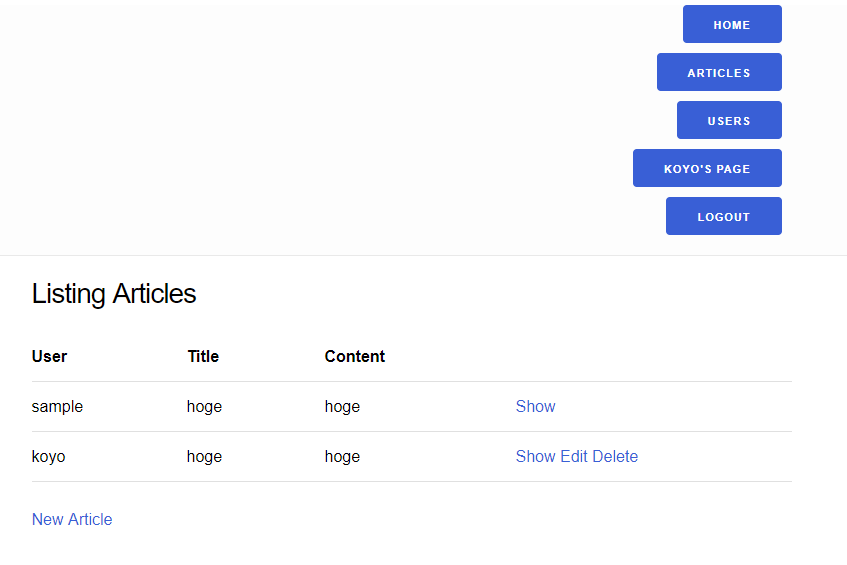
さて、今は画面側で表示していないだけなので、直接URL叩けば自分が所有していないarticleを操作できます
試してみましょう
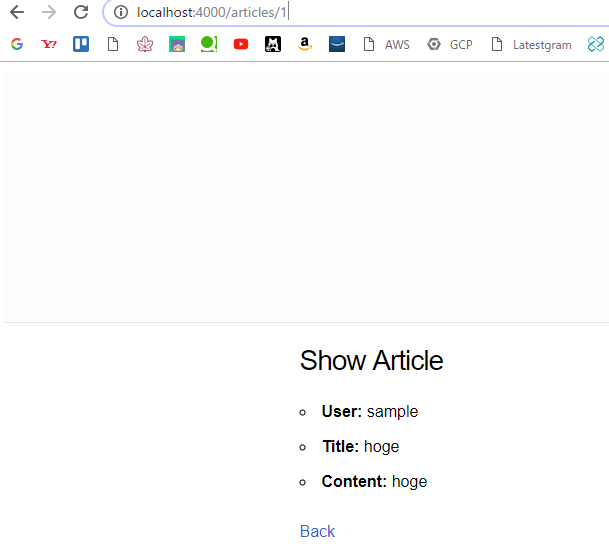
urlからsampleくんのidは1っぽいですね
localhost:4000/articles/1/editとすればeditできそうなので、やってみたらできました
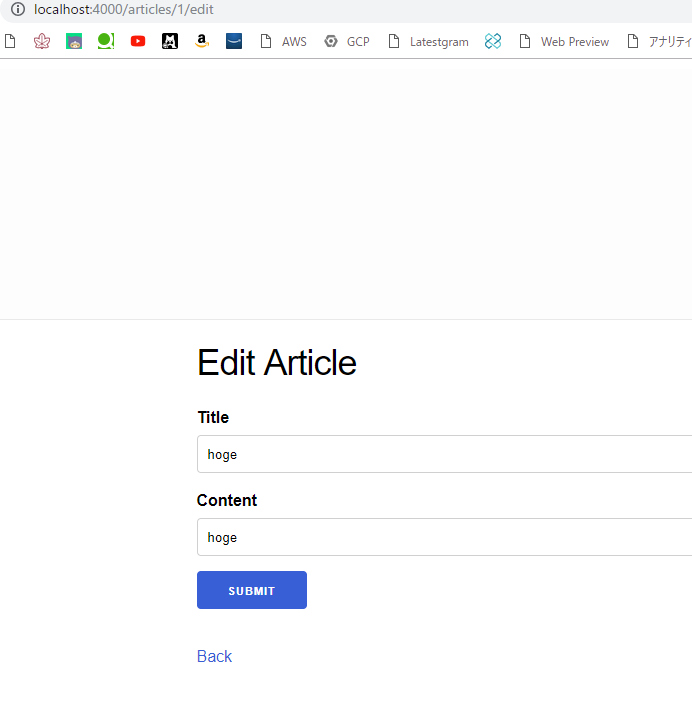
これはセキュリティ的に大変良くないので、コントローラ側で権限があるのかをチェックする必要がありますね
これは先ほどuserリソースでも同じことしているのでおさらいです
|> 自分自身が所有しているarticleのみ編集できるようにする
defmodule ExBlogWeb.ArticleController do
use ExBlogWeb, :controller
alias ExBlog.Blog
alias ExBlog.Blog.Article
alias ExBlog.Accounts
alias ExBlog.Accounts.Guardian
plug :is_authorized when action in [:edit, :update, :delete]
def index(conn, _params) do
articles = Blog.list_articles()
render(conn, "index.html", articles: articles)
end
def new(conn, _params) do
changeset = Blog.change_article(%Article{})
render(conn, "new.html", changeset: changeset)
end
def create(conn, %{"article" => article_params}) do
case Blog.create_article(Guardian.Plug.current_resource(conn), article_params) do
{:ok, article} ->
conn
|> put_flash(:info, "Article created successfully.")
|> redirect(to: Routes.article_path(conn, :show, article))
{:error, %Ecto.Changeset{} = changeset} ->
render(conn, "new.html", changeset: changeset)
end
end
def show(conn, %{"id" => id}) do
article = Blog.get_article!(id)
render(conn, "show.html", article: article)
end
def edit(conn, _) do
article = conn.assigns.article
changeset = Blog.change_article(article)
render(conn, "edit.html", article: article, changeset: changeset)
end
def update(conn, %{"article" => article_params}) do
article = conn.assigns.article
case Blog.update_article(article, article_params) do
{:ok, article} ->
conn
|> put_flash(:info, "Article updated successfully.")
|> redirect(to: Routes.article_path(conn, :show, article))
{:error, %Ecto.Changeset{} = changeset} ->
render(conn, "edit.html", article: article, changeset: changeset)
end
end
def delete(conn, _) do
article = conn.assigns.article
{:ok, _article} = Blog.delete_article(article)
conn
|> put_flash(:info, "Article deleted successfully.")
|> redirect(to: Routes.article_path(conn, :index))
end
# Current_user can access only own resources
# Check current_user's id match article.user.id
defp is_authorized(conn, _) do
current_user = Accounts.current_user(conn)
article = Blog.get_article!(conn.params["id"])
if current_user.id == article.user.id do
assign(conn, :article, article)
else
conn
|> put_flash(:error, "You can't modify that page")
|> redirect(to: Routes.page_path(conn, :index))
|> halt()
end
end
end
さてもう一度localhost:4000/articles/1/editを試してみると
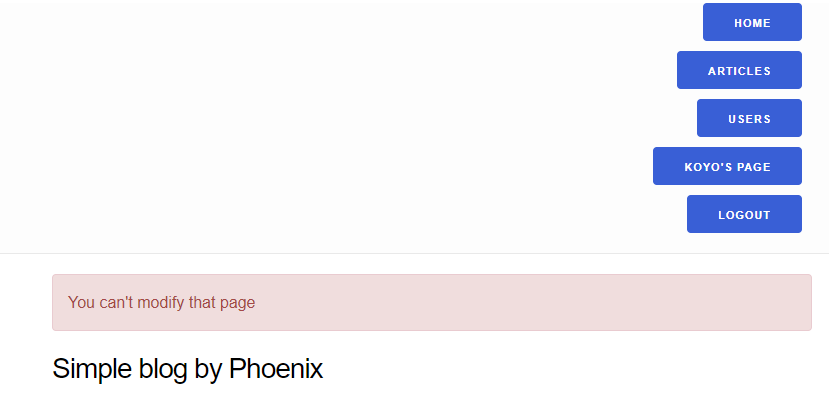
ちゃんと制限されましたね!
|> user/showに所有しているarticleの一覧を表示
これで最後です!
user/showのページに自分が所有しているarticleの一覧を出してみましょう
とはいえ簡単でuser/show.html.eexに以下を追加するだけです
<h2>Listing Articles</h2>
<table class="table">
<thead>
<tr>
<th>Title</th>
<th>Content</th>
<th></th>
</tr>
</thead>
<tbody>
<%= for article <- @user.articles do %>
<tr>
<td><%= article.title %></td>
<td><%= article.content %></td>
<td class="text-right">
<span><%= link "Show", to: Routes.article_path(@conn, :show, article), class: "btn btn-default btn-xs" %></span>
<%= if @user.id == current_user(@conn).id do %>
<span><%= link "Edit", to: Routes.article_path(@conn, :edit, article), class: "btn btn-default btn-xs" %></span>
<span><%= link "Delete", to: Routes.article_path(@conn, :delete, article), method: :delete, data: [confirm: "Are you sure?"], class: "btn btn-danger btn-xs" %></span>
<% end %>
</td>
</tr>
<% end %>
</tbody>
</table>
<%= if @user.id == current_user(@conn).id do %>
<span><%= link "New Article", to: Routes.article_path(@conn, :new) %></span>
<% end %>
koyoユーザはhoge, hoge1, hoge2のarticleリソースを持っていて、sampleユーザは別のhogeのarticleリソースを持っていますね
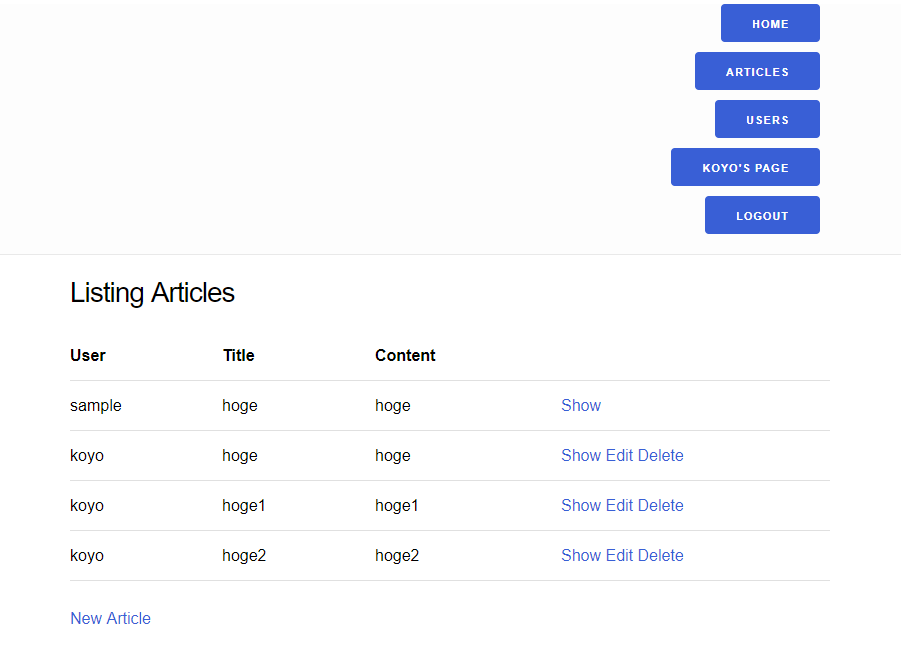
KOYO's PAGEリンクをクリックしてuser/showに遷移すると

koyoユーザが作成したarticleリソースの一覧が表示されています!
・・・これで一通り完成しました!お疲れ様です!
次はこれ以降の学習のヒントを示したいと思います
|> 追加課題
|> 自分なりの機能を追加してみる
このチュートリアルで簡単なブログアプリができました
ここまでやれば後はPhoenix公式ドキュメントを(英語苦手な人はGoogle翻訳駆使しながら)読んだり、EctoやGurdianのドキュメント読めば大抵のことはできるのではないでしょうか!(例えばarticleに対するcommentリソースを実装してみるといいかもしれないですね)
ぜひ自分のアイデアを実現させてみてください
|> テスト書いてみる
実運用ではテストは必須です!(というより、今回は説明のためテスト書かずに実装しましたが、慣れてきたらテストを先に書くTDDでやった方がいいです)
ElixirにはExUnitというテストフレームワークが標準装備なので、ドキュメント読みながら実装してみましょう!
ちなみにmix phx.gen.htmlで生成したコードにはすでにテストが自動生成されているので、まずはそれを参考にしてみるといいと思います
|> Gigalixirにデプロイしてみる
なんと!Elixirには専門のPaasであるGigalixirが存在します
使い勝手はHerokuみたいな感じです
ちょっと設定すればデプロイできるので、piacereさんの以下の資料を読んでチャレンジしてみてください!
【Gigalixir編①】Elixir/Phoenix本番リリース: 初期PJリリースまで
|> 参考
Phoenix1.3バージョンですが、githubのコードとGigalixirにデプロイしたアプリを置いておきますね!(Gigalixirの方は無料だと1アプリまでなので、そのうち消します・・・リンク切れていたらごめんなさい><)
テストもちょっとだけ書いたので参考になるかもしれません
ちなみに1.3ではpage_path(...)と記述していたところが1.4ではRoutes.page_path(...)というようにRoutesというモジュール名を明示的に書くように変更されているので、バージョンをまたぐ場合は適宜読み替えてください
|>Github
|>ex-blog.gigalixirapp.com
|> まとめ
Elixirのコードは可読性高くまとまりますね!
Phoenixを使えばRailsと遜色ないスピードで開発できて、しかもRailsの悩みである性能問題をある程度解消できます
おまけにアクターモデル由来の軽量プロセスにより耐障害性も高いんです(エッヘン)
このように単一CPU性能の向上を待たずして、メニーコアの性能を生かし切る可能性を秘めたElixir(Phoenix)が新たなトレンドになる日も近いかもしれません
是非触ってみてください!
次回はhykwさんの記事です!
